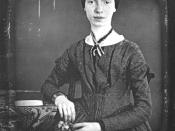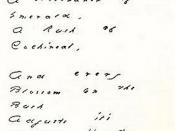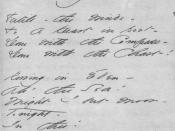Emily Dickinson's "I Heard a Fly Buzz" is a poem describing the event of one person's death. The poem is written in the first person which shows that the narrator has already died and is recounting the experience. The speaker is laying her deathbed, with family and friends standing all around, waiting for the inevitable. She wants to make her way to the afterlife, but a fly distracts her. As the woman dies, she finds herself not in the afterlife, but instead in the darkness. Emily Dickinson tries to show that while we may hope for an afterlife, no one can prove it exists.
In Dickinson's "I Heard a Fly Buzz" the speaker starts by describing herself on her deathbed surrounded by family and friends. The speaker's tone is calm while telling the story leading up to her death. There is "stillness in the air" (line 3), and those watching are deathly silent.
The speaker's senses have been heightened and all that she hears is the fly's insignificant buzz which is amplified by the stillness in the room. She says "I willed my keepsakes - - Signed away what portions of me be assignable" (line 9-11), and seems to be ready for death. While her family is waiting for her to pass on, she too has been waiting for something, the afterlife. She is waiting for the King to come down and take her to the afterlife. The speaker of the poem appears to have figured out what will happen at the time of her death. She is ready to die, then the fly appears which "interposed"(line 12) itself, "between the light and me"(line 14) and her peaceful transition to this heavenly place is interrupted. The fly represents nothing more than a problem or deviation from what is wanted.


